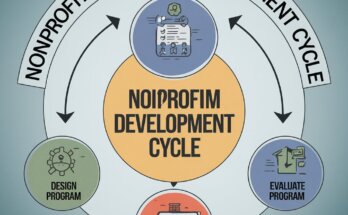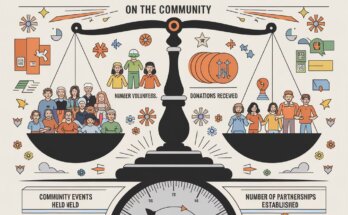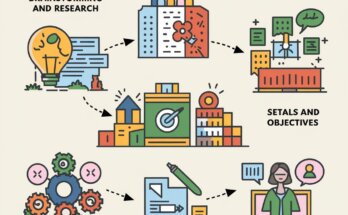When it comes to running a nonprofit program, having a clear structure and understanding the essential components is crucial. Many nonprofit leaders may wonder, “What exactly makes a program successful?”
In this blog post, we will explore the key components of a successful nonprofit program, highlighting practical examples and strategies to help you build a thriving initiative.
So, whether you’re launching a new program or enhancing an existing one, you’ll find valuable insights that can guide your efforts.
1. Clear Mission and Vision
The foundation of any successful nonprofit program is a clear mission and vision.
Your mission defines the purpose of your organization, while your vision outlines what you hope to achieve in the long run.
A strong mission statement resonates with your audience, inspires donors, and drives your team.
Example: Consider a nonprofit focused on literacy for underprivileged children. Their mission could be, “To empower children through literacy, ensuring every child has access to books and resources needed to succeed academically.” Their vision might be, “A world where every child reads at grade level, unlocking doors to opportunities.”
When developing your mission and vision, make them concise and memorable. Share them on your website, in presentations, and on social media. This consistency will help create a strong brand identity for your organization.
2. Comprehensive Needs Assessment
Before launching a program, conducting a comprehensive needs assessment is essential.
This process helps you identify the specific needs of your target population and the gaps your program can fill. By understanding the community you serve, you can design a program that addresses real issues.
Practical Strategy: Use surveys, focus groups, and interviews to gather data from community members and stakeholders. Analyze this information to determine the most pressing needs.
Example: If you’re developing a mental health program, gather input from potential participants, healthcare providers, and community leaders. This information will help you tailor your services to meet the unique needs of your community.
3. Engaging Program Design
Once you understand the needs of your community, it’s time to design your program. A successful program is engaging, inclusive, and adaptable. Involve your stakeholders in the design process to ensure the program resonates with those you aim to help.
Example:
Imagine a nonprofit organization that aims to provide job training for young adults.
They initially planned to offer a series of workshops. However, after engaging with potential participants, they learned that many young people prefer hands-on experience over traditional lectures.
In response, the organization pivoted to include internships and real-world projects in their program design.
This change significantly increased participation and engagement, leading to better outcomes for the participants.
To create an engaging program, consider incorporating various formats, such as workshops, online courses, mentorships, and networking events.
This diversity will cater to different learning styles and preferences, making your program more appealing.
4. Measurable Goals and Objectives
Setting measurable goals and objectives is critical for evaluating your program’s success. Use the SMART criteria (Specific, Measurable, Achievable, Relevant, Time-bound) to guide your goal-setting process.
Example: Instead of a vague goal like “improve literacy rates,” set a specific objective such as “increase the reading levels of 100 children by at least one grade level within six months.”
Establishing measurable goals allows you to track progress and make necessary adjustments to your program.
Regularly review these goals with your team and stakeholders to ensure everyone is aligned and aware of your program’s direction.
5. Strong Partnerships and Collaboration
Building strong partnerships and collaboration with other organizations, businesses, and community members can significantly enhance your nonprofit program.
Collaborations can provide additional resources, expertise, and outreach opportunities, ultimately leading to a more successful program.
Practical Example: A nonprofit focused on health education could partner with local schools, healthcare providers, and community centers to expand their reach. This collaboration might include co-hosting workshops, sharing resources, and cross-promoting each other’s events.
When forming partnerships, seek organizations that share similar values and missions. By working together, you can amplify your impact and create a more sustainable program.
6. Effective Communication Strategies
Clear and effective communication is vital for the success of any nonprofit program. Keep your stakeholders informed about your program’s goals, activities, and achievements. Use multiple channels, including newsletters, social media, and community meetings, to share updates.
Example: A nonprofit focused on environmental conservation might use social media to showcase their successes, such as planting trees or cleaning up local parks. By regularly sharing these stories, they can engage their audience, attract new supporters, and demonstrate their impact.
Additionally, consider creating a communication plan that outlines how and when you will share information with your stakeholders. This plan can help you maintain consistency and ensure everyone is on the same page.
7. Evaluation and Feedback Mechanisms
To ensure your program is effective, implement evaluation and feedback mechanisms. Regularly assess your program’s performance and gather feedback from participants, staff, and stakeholders. This information will help you identify strengths and areas for improvement.
Practical Strategy: Conduct surveys and interviews with program participants to gather feedback on their experiences. Use this data to make informed decisions about program enhancements.
Example: If participants in a youth mentorship program express that they need more structured activities, you can adjust the curriculum to include more hands-on projects or team-building exercises. This responsiveness to feedback demonstrates your commitment to continuous improvement and participant satisfaction.
8. Sustainable Funding Strategies
A successful nonprofit program requires sustainable funding to operate effectively. Explore various funding sources, including grants, individual donations, corporate sponsorships, and fundraising events. A diverse funding strategy can help ensure your program’s longevity.
Practical Example: A nonprofit focused on providing meals to low-income families might seek grants from local foundations, establish monthly giving programs, and host annual fundraising events. By diversifying their funding sources, they can create a more stable financial foundation.
Additionally, consider developing a compelling case for support that clearly articulates the need for your program, its impact, and how donors can contribute. This approach can help you attract new supporters and secure ongoing funding.
9. Building a Strong Team
Having a strong team is essential for the success of any nonprofit program. Recruit individuals who are passionate about your mission and possess the skills necessary to help your program thrive. Invest in training and professional development to empower your team and ensure they have the tools they need to succeed.
Example: If you’re launching a mental health program, seek professionals with experience in psychology, counseling, or social work. Additionally, provide ongoing training opportunities to help your team stay updated on best practices and emerging trends in the field.
Encourage a positive organizational culture that values collaboration, open communication, and continuous learning. A motivated and skilled team will be more effective in implementing your program and achieving its goals.
10. Community Engagement and Advocacy
Engaging with the community and advocating for your cause is vital for your nonprofit program’s success. By actively involving community members and stakeholders, you can build trust, raise awareness, and mobilize support for your initiative.
Practical Strategy: Host community events, workshops, and informational sessions to educate the public about your program and its impact. Encourage community members to share their experiences and become advocates for your cause.
Example: A nonprofit focused on affordable housing might host community forums to discuss housing challenges and gather input from residents. By fostering open dialogue, they can strengthen their relationships with community members and advocate more effectively for policy changes.
Taking Action for Success
In summary, the key components of a successful nonprofit program include a clear mission and vision, comprehensive needs assessment, engaging program design, measurable goals, strong partnerships, effective communication strategies, evaluation mechanisms, sustainable funding, a strong team, and community engagement. By focusing on these essential elements, you can create a program that truly makes a difference.
To continue enhancing your nonprofit efforts, subscribe to the Nonprofit Navigators Newsletter for more expert tips and resources.
Don’t miss out, download, “Top 10 Donor Stewardship Strategies for Nonprofits + Free Donor Engagement Checklist.” This valuable resource will help you strengthen your donor relationships and enhance your fundraising efforts.
Remember, every successful nonprofit program starts with a strong foundation. Implement these strategies today, and watch your program flourish!




